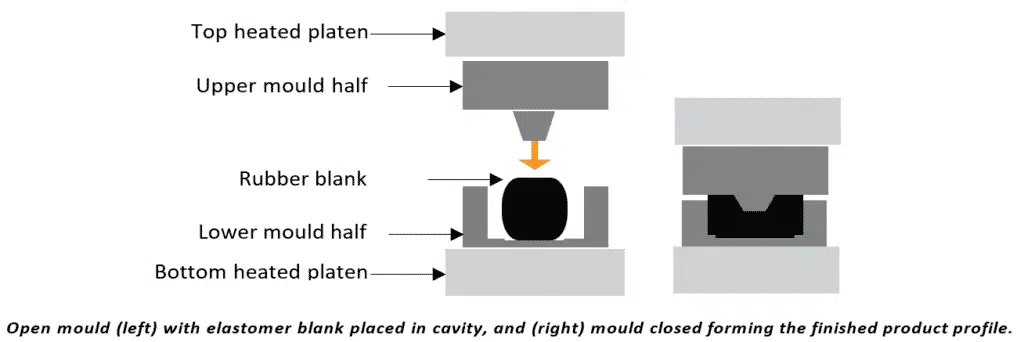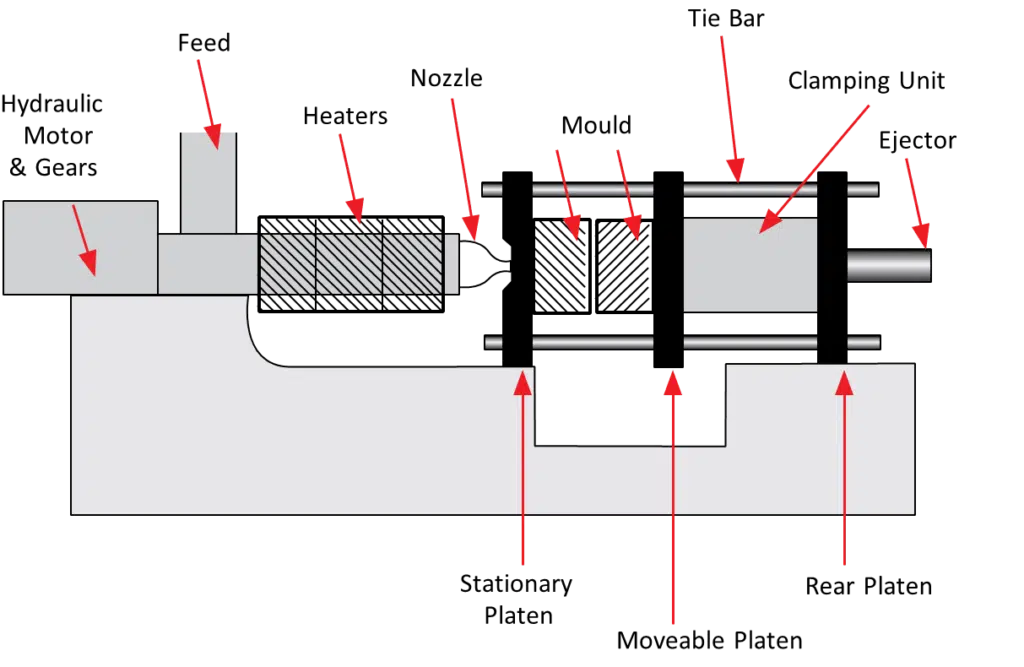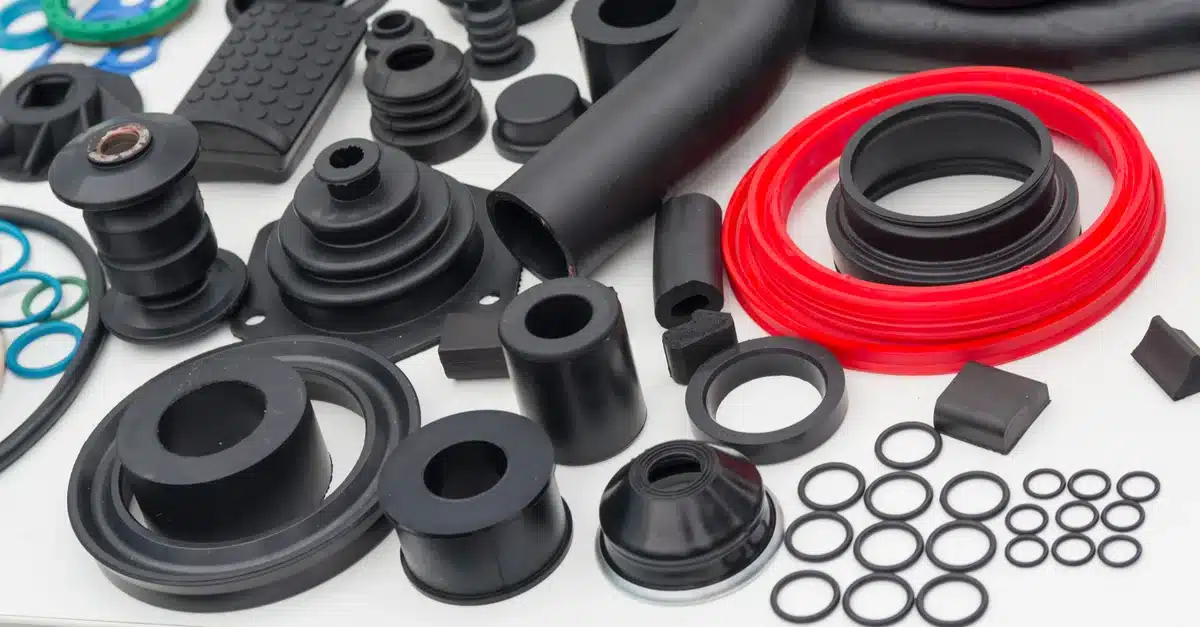Compression Rubber Moulding
Understanding Compression Rubber Moulding

Compression rubber moulding is a widely used manufacturing technique in the rubber industry, offering efficient and precise ways to shape rubber materials into various products.
Compression rubber moulding involves a straightforward yet effective process that transforms rubber materials into desired shapes. The process begins by preheating the rubber material and placing it into a mould cavity. The mould is then closed, and pressure is applied to compress the rubber within the mould. The heat and pressure combination allows the rubber to flow, filling the mould cavity and taking on its desired shape. After sufficient curing time, the mould is opened, and the finished rubber product is removed.
Compression Moulding - A step-by-step guide
If you’re looking to gain a more comprehensive understanding of the compression rubber moulding process, this step-by-step guide will walk you through the key stages involved, providing valuable insights into this efficient manufacturing method.
Step 1: Material Preparation The first step in compression rubber moulding is preparing the rubber material. This involves selecting the appropriate type of rubber, such as natural rubber or synthetic elastomers, and preparing it in a form suitable for moulding. The rubber is typically cut into manageable pieces or preformed into slabs or sheets for easier handling.
Step 2: Mould Design and Preparation Next, the mould design is created or selected based on the desired final shape and specifications of the rubber product. The mould is carefully designed to account for factors like parting lines, vents, and gating systems. Once the mould design is finalized, it is prepared by cleaning and applying mould release agents to ensure easy demoulding later in the process.
Step 3: Preheating the Mould and Rubber The mould is preheated to an optimal temperature that facilitates rubber flow and curing. Simultaneously, the rubber material is heated in an oven or on a hot plate to achieve the appropriate temperature for moulding. Preheating both the mould and the rubber material ensures uniform heat distribution and promotes efficient mould filling.
Step 4: Loading and Compression With the mould and rubber material appropriately heated, the rubber is placed into the mould cavity. The mould is then closed, and pressure is applied to compress the rubber. The compression forces the rubber to flow and fill the entire mould cavity, taking on its desired shape. The applied pressure also aids in removing any air or trapped gases from the mould, ensuring proper material distribution.
Step 5: Curing and Cooling After compression, the rubber product undergoes a curing phase to facilitate cross-linking and achieve the desired physical properties. The curing process involves maintaining the mould at a specified temperature and duration, allowing the rubber to solidify and cure. Once cured, the mould is cooled down, either by natural cooling or with the help of cooling systems, until the rubber has sufficiently solidified.
Step 6: Demoulding and Finishing Once the rubber product has cooled and solidified within the mould, the mould is opened, and the finished part is carefully removed. The demoulding process requires caution to prevent any damage to the rubber component. After demoulding, any excess flash or excess rubber are trimmed or removed, and the finished product undergoes any necessary post-finishing processes like inspection, cleaning, and packaging.

What are the benefits of Rubber Compression Moulding?
Compression rubber moulding offers several advantages that make it a preferred choice for manufacturers:
Versatility: The process accommodates a wide range of rubber materials, including natural rubber, synthetic rubber, and elastomers, allowing for flexibility in material selection based on specific application requirements.
Cost-Effectiveness: Compression rubber moulding is a cost-effective method, particularly for low to medium volume production. The simplicity of the process, coupled with the durability and longevity of rubber products, provides an economical solution without compromising quality.
Precision and Customization: With rubber compression moulding, manufacturers can achieve high precision and customization. Complex geometries, intricate details, and tight tolerances can be faithfully reproduced, ensuring the production of tailored rubber components that meet exact specifications.
Material Properties: Compression moulding allows for the incorporation of additives and reinforcements, enhancing material properties such as strength, flexibility, chemical resistance, and heat resistance. This enables the production of rubber products with improved performance characteristics.
What are the drawbacks of rubber compression moulding?
While compression rubber moulding offers numerous advantages, it’s important to consider some of the potential limitations or challenges associated with the process. These disadvantages, though not overly negative, are worth keeping in mind. Let’s explore them:
Longer Production Time: Compression rubber moulding generally requires longer cycle times compared to other moulding methods like injection moulding. The curing process and the need for sufficient heat and pressure can extend the overall production time. This aspect may impact the ability to produce large quantities quickly.
Manual Labour: Compression moulding often involves manual labour for tasks such as loading the rubber material into the mould and removing the finished products. While this allows for flexibility and adaptability, it can lead to increased labour costs and potential variability in the final output.
Limited Design Complexity: The design flexibility in rubber compression moulding may be somewhat restricted when compared to other moulding techniques. Complex part geometries, intricate details, or undercuts may be challenging to achieve with compression moulding. Alternative methods, such as injection moulding, may offer more design freedom for highly intricate or complex components.
Material Waste: The manual loading of rubber material in compression moulding may lead to some material waste due to variations in the amount of rubber used and trimming of excess flash. While steps can be taken to minimize waste, it’s important to consider material efficiency in the production process.
Tooling Costs: Developing custom moulds for compression rubber moulding can involve initial tooling costs. The creation of precise moulds tailored to the desired part shape and size requires skilled expertise and specialized equipment. These upfront costs should be taken into account during the planning phase of a project.
Limited Automation: Compared to certain moulding techniques like injection moulding, automation options for compression rubber moulding may be more limited. The need for manual labour and the variability in material placement and curing make full automation challenging. However, advancements in automation technology continue to enhance the efficiency and consistency of compression moulding processes.
Compression Moulding Applications
Rubber compression moulding finds a wide range of applications across various industries due to its ability to produce precise and customized rubber components. The versatility and durability of rubber make it an ideal material for applications requiring sealing, vibration isolation, impact absorption, and more. Here are some common applications of rubber compression moulding:
Seals and Gaskets: Rubber compression moulding is extensively used in the production of seals and gaskets. These components are crucial for creating airtight and watertight seals in applications such as automotive engines, hydraulic systems, pumps, and industrial machinery. Compression moulding allows for the creation of seals and gaskets with precise dimensions and desired material properties to ensure optimal sealing performance.
O-Rings: O-rings, also known as toric joints, are widely used in hydraulic and pneumatic systems to provide effective sealing against fluid or gas leakage. Compression moulding enables the production of O-rings in various sizes and materials, ensuring a reliable and secure seal in applications ranging from automotive engines to industrial equipment.
Bushings and Mounts: Rubber bushings and mounts are employed to absorb shocks, vibrations, and noise in various mechanical systems. They provide cushioning and isolation, reducing the transmission of vibrations and enhancing equipment performance and longevity. Compression moulding enables the production of rubber bushings and mounts with specific durometer ratings and dimensional accuracy, catering to the needs of different industries like automotive, aerospace, and machinery.
Custom Rubber Parts: Compression moulding is ideal for manufacturing custom rubber parts tailored to specific requirements. These can include components such as grommets, bellows, diaphragms, and custom-designed rubber pieces for specialized applications. Compression moulding allows for intricate designs, complex geometries, and the integration of inserts, offering flexibility and customization options for various industries.
Electrical Insulation Components: Compression moulding is utilized in the production of electrical insulation components like insulating boots, grommets, and wire harness seals. These components provide protection and insulation in electrical systems, preventing the entry of moisture, dust, and other contaminants. Compression moulding ensures the production of precise and reliable insulation parts with suitable electrical properties and resistance to environmental factors.
Medical and Healthcare Devices: Compression rubber moulding plays a vital role in the production of medical and healthcare devices. It is used to manufacture items such as surgical seals, diaphragms, valve components, and drug delivery systems. The biocompatibility, flexibility, and durability of rubber make it suitable for applications in medical devices, where precision, cleanliness, and adherence to strict quality standards are crucial.

Compression moulding vs Injection Rubber Moulding
When deciding between compression rubber moulding and injection rubber moulding, several factors come into play. While both techniques are used for manufacturing rubber components, there are certain instances where compression rubber moulding is the preferred choice.
Material Selection: Compression rubber moulding offers greater flexibility in material selection compared to injection moulding. It can handle a broader range of rubber materials, including specialized elastomers and custom formulations. If your application requires specific material properties or if you need to work with unconventional rubber compounds, compression moulding allows for more options.
Lower Production Volumes: If you require smaller production volumes, compression rubber moulding tends to be more cost-effective. Injection rubber moulding often involves higher upfront tooling costs, making it more suitable for high-volume production runs. Compression moulding, on the other hand, offers greater cost efficiency for low to medium production volumes, making it a viable option for prototypes, custom parts, and specialized applications.
Complex Geometries and Inserts: Compression rubber moulding is better suited for parts with complex geometries or those requiring inserts. Since the rubber material is placed directly into the mould cavity, compression moulding can accommodate intricate shapes and design features that may be challenging with injection moulding. Additionally, compression moulding allows for the incorporation of inserts, such as metal components or reinforcement elements, during the moulding process.
Improved Material Distribution and Dimensional Control: Compression moulding provides better control over material distribution, resulting in consistent and uniform properties throughout the finished product. This is particularly important for applications where tight dimensional control and uniformity are critical. Compression moulding allows for precise control over variables such as pressure, temperature, and curing time, leading to better control over part dimensions and quality.
Prototyping and Customization: Rubber Compression moulding is well-suited for prototyping and customization due to its flexibility and ability to produce small quantities. If you need to test a design, make modifications, or produce unique and tailored rubber components, compression moulding allows for rapid iterations and customization without significant tooling changes or high costs.

What is a Mould plate and what material should I choose?
In compression rubber moulding, a mould plate refers to a key component of the mould used to shape and form the rubber material. It is a flat or contoured plate that creates the desired shape and structure of the final rubber part. The mould plate consists of two halves, the top half and the bottom half, which come together to enclose the rubber material during the moulding process.
When preparing for compression moulding, the rubber compound is placed between the two mould plates. The top and bottom halves of the mould are then brought together, with the rubber compound sandwiched in between. The mould plates have carefully designed cavities and features that define the shape, dimensions, and surface details of the finished part.
Choosing the right mould plate material is crucial for achieving successful compression rubber moulding results. The mould plate material plays a significant role in ensuring dimensional accuracy, heat transfer, durability, and overall performance of the mould. Here are some factors to consider when selecting a mould plate material for compression moulding:
Heat Resistance: Rubber compression moulding involves subjecting the mould to elevated temperatures during the curing process. Therefore, the mould plate material should have excellent heat resistance to withstand the curing temperature without deformation or degradation. Commonly used mould plate materials with good heat resistance include tool steels (e.g., P20, H13), aluminium alloys, and certain grades of stainless steel.
Wear Resistance: The mould plate material should have high wear resistance to withstand the repeated cycles of compression and release. Rubber can be abrasive, especially with certain compounds, so a wear-resistant mould plate material will help prolong the mould’s lifespan and maintain dimensional accuracy. Tool steels such as D2 and A2 are known for their good wear resistance properties.
Corrosion Resistance: Depending on the rubber compound and the curing process, corrosive elements like chemicals or moisture may be present. Choosing a mould plate material with excellent corrosion resistance is essential to prevent rust or chemical degradation. Stainless steel alloys, such as 420 or 440C, are commonly used for their corrosion resistance properties.
Thermal Conductivity: Efficient heat transfer is crucial during compression rubber moulding to ensure proper curing and consistent material flow. A mould plate material with high thermal conductivity helps dissipate heat evenly throughout the mould, resulting in uniform curing and preventing hotspots. Aluminium alloys, known for their high thermal conductivity, are often used for mould plates in compression moulding.
Dimensional Stability: The mould plate material should exhibit excellent dimensional stability to maintain precise part dimensions and avoid warping or distortion during the curing process. Materials like tool steels, which have good dimensional stability, are commonly chosen for compression rubber moulding applications.
Cost Considerations: The cost of the mould plate material is also an important factor to consider. Tool steels are generally more expensive compared to aluminium alloys. However, the choice should be based on the specific requirements of the application and the desired mould lifespan.

At Kea-Flex we have years of experience in the rubber moulding sector and our proud of our dedicated team of experts. For more information about compression rubber moulding and the services we offer, contact us today on 01420 473 645.
Or if you are simply interested in reading more about compression moulding, click here to read our page on the advanced insights of rubber moulding through compression.

